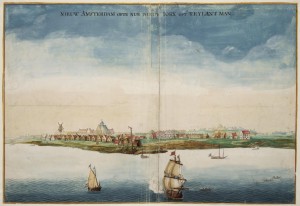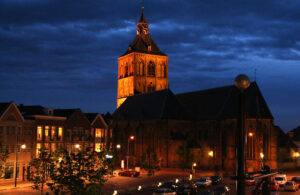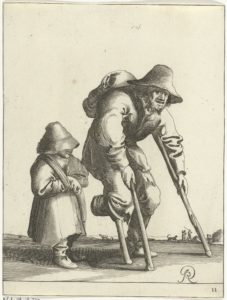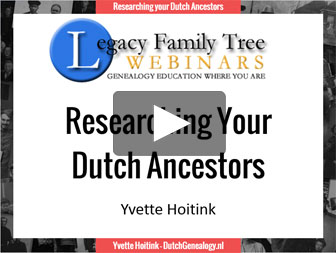In 1659, the famous mapmaker Joan Blaeu published his world atlas Tooneel des Aardrycks [Display of the Realm of Earth]. The archives in Leiden have made their atlas available online. This week we are looking at Blaeu's map of the Duchy of Limburg. In the east, we can see the river Meuse [Maas in Dutch, "Mosa Fluvius" on the map] connecting the cities of Maastricht ("Maestricht") and Luik ("Luyck vel Liege"). Limburg is in the higher part of the Netherlands, so we see more woods and hills, … [Read more...]
New Netherland Ancestors Seminar
The New York Genealogical & Biographical Society is hosting a one-day virtual seminar about New Netherland ancestors on 2 May 2025. John Blythe Dobson will share how to discover New Netherland settlers in published sources, and how we are developing sketches fo rthe New Netherland Settlers project. I will be giving presentations about tracing New Netherland Ancestors in the Netherlands and researching enslaved and native people in and around New Netherland. For details, fees, and … [Read more...]
Dutch term – Vaandrig
A vaandrig is an ensign, the lowest officer rank in the army. From the 1800s, the term is more specifically used for officers-in-training. The rank was also used in civil militias. You may come across the term in a range of records, including military records, church records, and town records. … [Read more...]
Dutch Genealogy News for February 2025
Here is an overview of the new sources, websites, and other news of the past month. Sources Court records of several local courts in Groningen, mainly for the 1600-1811 period, are now available via FamilySearch. Birth, marriage, and death records of several municipalities in Noord-Brabant are now scanned and indexed and available via the Brabants Historisch Informatie Centrum. These are mainly records that have become public in recent years. Several church records of Hoorn have been … [Read more...]
Dutch term – Herder
A herder usually is a shepherd. The term is also sometimes used for a cowherd, though that is more often called a koeherder. In areas with large moors, you may find this as an occupation for adults. Some farmers who had some some land that was not arable kept a few sheep and hired a young boy, a herdersjongen [shepherd boy] to herd them. … [Read more...]
Quick Tip- The Best Of Times, The Worst Of Times
When researching ancestors we did not know personally, we rarely see them on an average day. We may see them at the best of times: when they get married, when they have a child, or when they receive a medal. Or we may see them at the worst of times: when they lose a child, when they go bankrupt, or are prosecuted for a crime. Average days typically do not create many records. If we are lucky, we might find a witness statement where they were going about their normal work when something … [Read more...]
Using Occam’s Razor in Genealogy
Occam's Razor is a philosphical tool that helps you zoom in on the most likely explanation. A lot has been written about Occam's Razor, but it boils down to "the simpler explanation is usually correct." We can use this in genealogy in different ways: We can use Occam's Razor to determine the most likely hypothesis. If we find a combination of unusual circumstances, Occam's Razor tells us that a single cause that explains all events is more likely to be correct. This can allow us to … [Read more...]
Map of the Week – Groningen, 1659
In 1659, the famous mapmaker Joan Blaeu published his world atlas Tooneel des Aardrycks [Display of the Realm of Earth]. The archives in Leiden have made their atlas available online. This week we are looking at Blaeu's map of the province of Groningen. It shows its largest city as the same-named Groningen ("Gronningen" on the map), connected to the North Sea by the Reitdiep. The map shows the roads and rivers that connected the smaller towns. See the research guide for Groningen for more … [Read more...]
Dutch Genealogy News for January 2025
Here is an overview of all the new sources, projects, and other news annnounced this month. Sources The index to the Central Archives of Special Jurisdiction came online. See this blog post for more information. Birth records of Bathmen (1881-1902), Olst (1884-1891), and Raalte (1846-1855) in Overijssel are now available via Open Archives. The burial register of the Dutch Reformed Church of Welsum (1836-1907) is now available via Open Archives. The Zeeuws Archief finished … [Read more...]
Quick tip – Look at laws and ordinances
Looking at laws and local ordinances can help us understand the information in records we find. These can typically be found in the series of town records in the local or regional archives. For example, when the hospital bill of my ancestor Cornelia Platschart was sent to the police, I initially thought she was incarcerated. It was not until I looked at the local ordinances that I realized that the police oversaw prostitutes and sent women who were ill to the hospital. See Using Hospital … [Read more...]











